Seasons – April 2023
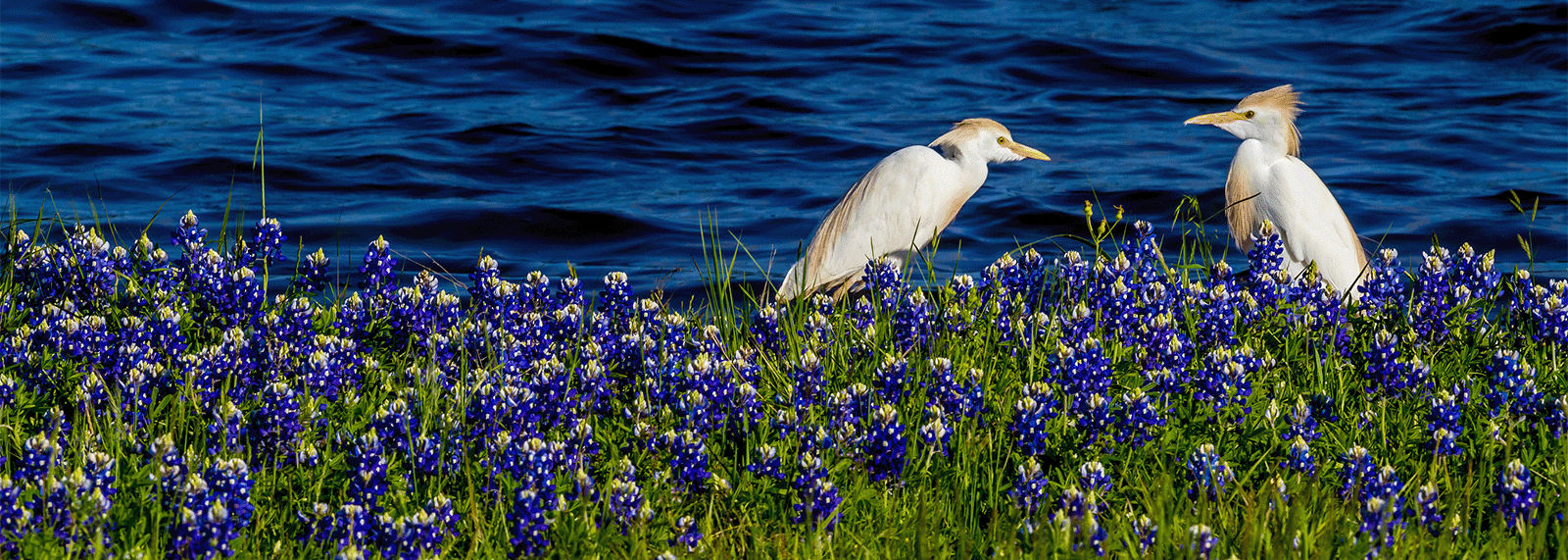
From the Plateau Land & Wildlife Management Team
The winter months are officially behind us, and spring has sprung. We are always happy for spring’s arrival for so many reasons; the budding trees, the greening grass, newborn wildlife, and the slowly warming weather are all wonderful. If you take a minute to notice the transformation happening around you, you can’t help but be in awe.
In this issue of Seasons, you’ll find guides by Plateau’s team of biologists and Wildlife Management staff to help you enjoy the changing landscape and make the most out of the spring season. We’ll cover tips for identifying birds you can see during spring migration, spring pest control that can count as a Wildlife Management activity, funding opportunities for improvement projects on your land, educational webinars, news for Texas Landowners and more.
We hope you enjoy all this edition of Seasons has to offer and, as always, we are here to help when you need it!
Until next Seasons,
The Plateau Team

Table of Contents
Birds You Can See on Your Property This Spring
Webinar: How Spring Migration Affects Landowners
Wildlife Management Activity Reminder: Imported Red Fire Ant Control
Hill Country Headwaters Conservation Initiative Funding Available
Plateau Featured Speaker at “Owning Your Piece of Texas” Workshop
Top Five Things to Consider When Crafting Your Estate Plan
News for Texas Landowners
Birds You Can See on your Property this Spring
By Danielle Belleny, Staff Biologist, Senior Property Tax Consultant
Each year, billions of birds engage in an annual cross-continental migration that transports them from their tropical wintering grounds in South and Central America to their breeding grounds in North America. The migrant birds begin to trickle into Texas around late February as the warming weather promises lush and resource-plentiful times ahead.
Landowners will begin to notice the colorful migratory birds that settle within the habitats on their properties become increasingly noticeable, especially by sound. The colorful, feathered denizens bring cheerful songs that are used to defend their breeding territories as well as attract a mate. Additionally, for nature enthusiasts, the songs and sights provide a season’s worth of entertainment and a scientific way to assess bird populations in an area.
Here are some migratory bird species that landowners may encounter and support on their properties, separated by Texas regions:
Hill Country
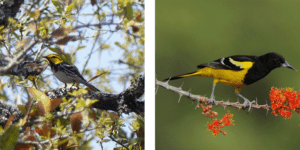
Golden-cheeked Warbler (left) and Scott’s Oriole (right)
Golden-cheeked Warblers have radiant yellow faces accented with black crests and a contrasting white belly. They are highly specialized and only breed in mixed juniper-oak woodlands in central Texas. The woven nests of these warblers are made from strips of old-growth Ashe juniper bark. Golden-cheeked Warblers eat insects including beetles, caterpillars, and flies. Males can be heard belting their loud buzzy songs beginning in March. Drastic declines in Golden-cheeked Warbler populations can be attributed to the loss of mature Ashe juniper habitat required at their breeding grounds. Golden-cheeked Warblers are listed as Federally Endangered under the US Fish & Wildlife Service. Properly managing breeding habitats for Golden-cheeked Warblers will help keep this local Texas species around for future generations to experience. Expect to see Golden-cheeked Warblers in this region from March to September.
The lemony Scott’s Orioles are identified by their dazzling yellow body feathers seen in both males and females. The bodies of the males are contrasted with black wings, head, bib, and tail. Female Scott’s Orioles lack black markings and have olive-colored head and wing feathers. Scott’s Orioles forage in taller vegetation for insects and can be frequent bird feeder visitors when enticed by fresh orange slices and grape jelly. Scott’s Orioles are closely associated with yuccas. The plant’s leaves provide nesting materials and flowers provide nectar for the birds to eat. Expect to see Scott’s Orioles in this region from March to October.
East Texas
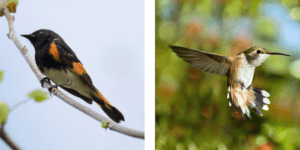
American Redstart(left) and Ruby-throated Hummingbird (right)
American Redstarts are Halloween-themed warblers that have sweet songs that sound like squeaky wheels. Males have black feathers covering their heads, wings, and tails with bright orange flashes of color on their sides and outer tail feathers. Females have pale gray heads, rusty orange backs and wings, and yellow feathers extending from their wing pits to their chests. American Redstarts breed in deciduous forests and mixed woodlands near lakes, streams, and swamps. Redstarts primarily eat insects, often catching them mid-air, and occasionally eat berries. They can be seen flicking and fanning their tails while they forage in tree canopies. Expect to see American Redstarts in this region from April to June.
Ruby-throated Hummingbirds are the infamously bejeweled fast-moving birds seen darting from flower to flower delicately collecting nectar with their elongated beaks. They can be found in woodland and brushy environments. The bird’s buzzing sounds are caused by their wings beating 50 times per second. Alternatively, they can be heard marking chirping calls while dueling for a flower or their favorite spot at the hummingbird feeder. Plant native flowers that bloom red or orange to attract more hummingbirds to your yard. A careful eye can spot the tiny nest of a Ruby-throated Hummingbird. They are constructed of spiderwebs, lichen, and mosses and are wedged securely in the terminating ends of deciduous tree branches. Expect to see Ruby-throated Hummingbirds in this region from March to November.
Central Texas
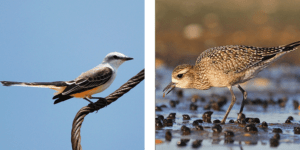
Scissor-tailed Flycatcher (left) and American Golden-Plover (right)
Scissor-tailed Flycatchers are easily identified by their long forked tail that can reach 9 inches in length. The flycatcher opens and closes its tail during its high-energy acrobatic flights. The salmon pink wings, ashy grey body, black-tipped tail, and unmistakable silhouette are best observed while the bird is in flight. Scissor-tailed Flycatchers forage grasslands for insects, about 50% of their diets are grasshoppers. You can commonly find scissor-tailed in small groups chattering on telephone wires and dotting the canopies of trees along urban and rural roads. Expect to see Scissor-tailed Flycatchers in this region from March to November.
American Golden-Plovers are shorebirds commonly found in pastures, tilled farmland, and weedy shallow ponds. They have one of the longest migrations of any shorebirds and fly from their South American wintering grounds to their arctic breeding grounds in Alaska and Canada. American Golden-Plovers can be seen stopping in Texas to fatten up on invertebrates, seeds, and berries before they complete their migration. They can be noticed by their run-stop-scan feeding technique in flat fields or by their rapid series of whimsical whistling calls. In breeding plumage, both males and females look very similar. They have black heads with white neck sides and earthy brown shades accented with golden flecks on their backs. Expect to see American Golden-Plovers in this region from March to June and again from September to December.
Get outside and see what’s out there!
Whether you are in Wildlife Management or not, an exciting activity for many landowners is watching and identifying the various birds that frequent your property. With spring upon us and migration underway, now is the time to get outside on your property and see which species of birds are prevalent. Need some help getting started? Partner with Plateau for a Spring Breeding Bird Survey. These surveys are a great opportunity for landowners to practice their birding skills and tour their property with a professional wildlife biologist while visiting a number of bird survey stations to detect birds either through visual or auditory observation. Detailed reports are produced with all species and numbers observed, brief habitat and location descriptions for each station, counting as a Wildlife Management Activity.
If you’re interested in learning more about Plateau’s Spring Breeding Bird Survey, or would like to schedule one for your property call (512) 894-3479 or email [email protected].
Back to TopBack to Top
How Spring Migration Affects Landowners
Billions of birds are on the move across North America this spring as they migrate to their northern breeding areas. In this webinar, Certified Wildlife Biologist James Hall details the types of migratory species that can be spotted in Texas this season, and actions landowners can take during the season to help native Texas wildlife. For those in Wildlife Management, Hall explains how certain Wildlife Management Activities can support songbirds and other migratory birds as they pass through Texas this spring.
Back to TopBack to Top
Wildlife Management Activity Reminder: Imported Red Fire Ant Control
By Kameron Bain, Landowner Account Manager
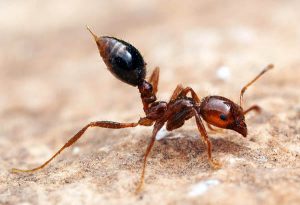
Warmer weather means spring is here – and so are the fire ants. As mounds start to appear on your property, it means an increase in ant activity, which is bad news for other insects and arthropods, ground-nesting birds, and small wildlife of all kinds.
Imported red fire ants are an invasive species from South America first coming to this country in the 1930’s. Not only are they a nuisance to humans, but they also impact wildlife including deer, quail, and other ground nesting birds. Fire ants prey on and compete with other insects for the same food sources. Beyond direct predation on larger wildlife, the reduction in essential insects and other arthropods that nesting birds and small mammals need creates a ripple effect in the ecosystem as a whole, resulting in a shortage of food up the chain and a reduction in species diversity.
Plateau recommends treating imported red fire ants in the spring through early summer and again in the fall. Spring treatments reduce ant numbers when wildlife are most vulnerable to predation, while fall treatments help reduce the number of mounds that appear the following spring. Now is a great time for your first treatment of the year.
Treatment Recommendations:
If at all possible, spot treat individual mounds with bait-style insecticides like Extinguish Plus or Amdro Pro that require the ants to ingest it. This reduces impacts to non-target ants and other insects. Contact insecticides like those containing pyrethrins can be effective when spot-treating as well, but will kill other insects that they contact. Organic treatments using spinosad and citrus oils are also available if you prefer to avoid synthetic insecticides.
If you have more than 20 fire ant mounds per acre, then you might consider broadcasting baits following the label directions. Keep in mind that this technique will likely impact native ants more than individual mound treatments.
Be sure to note the date of any treatments, take some example photos of treated mounds, and note the area you treated on a map to help ensure you covered the acreage required in your wildlife management plan.
A good program is both highly effective in treating fire ants and will benefit native wildlife as well. Always follow label directions before applying, and if you have grazing livestock on your property or cut hay, be sure to check for any restrictions on your chosen product.
Plateau’s Imported Red Fire Ant Treatment and Control uses GPS technology and aerial imagery to accurately locate treatment areas and eliminate fire ants with an effective, compliance-ready dual action insecticide treatment. To schedule a IRFA treatment for your property, contact us at [email protected] or (512) 894-3479.
Hill Country Headwaters Conservation Initiative Funding Available
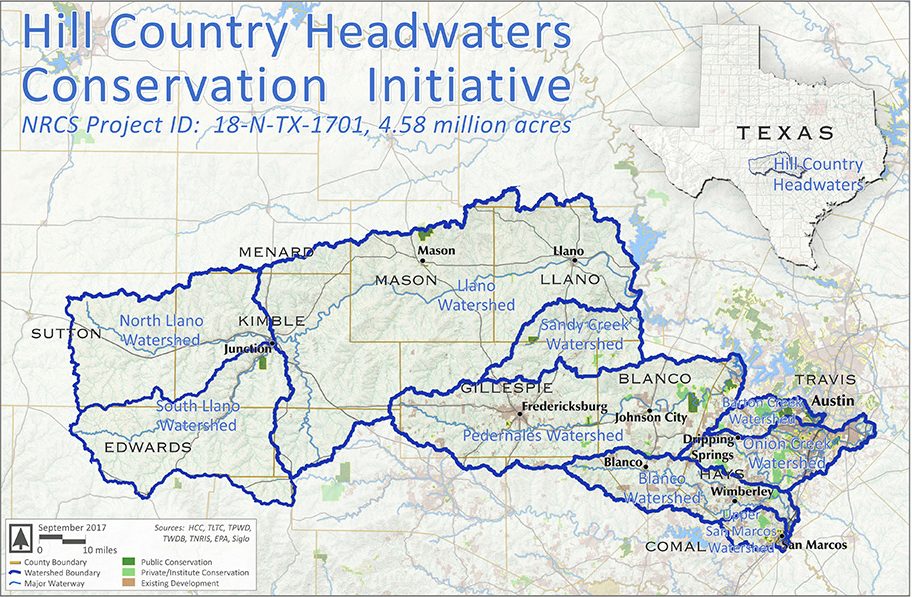
- Enhancing riparian buffers
- Managing livestock impacts to water bodies and providing alterative water sources
- Planned grazing and grazing deferments to promote enhanced forage quality, soil cover, and wildlife habitat
- Fencing improvements to promote wildlife passage and grazing management
- Range planting (seeding of native grasses and forbs)
- Improving pollinator and monarch habitat
- Brush management (emphasizing removal of regrowth on deep soils in flat areas)
- Instream habitat enhancement
- Irrigation efficiency improvements
How to Get Started
To be considered for financial assistance, landowners must take this first step in the application process by completing the pre-application form by April 17, 2023. Apply here: https://hillcountryconservancy.org/…/land-projects-hchci/. Want to learn more? Join their FREE informational webinar on April 14, 10:00-11:30am. Register here: https://bit.ly/41iGsK7
Back to TopBack to Top
Plateau Featured Speaker at “Owning Your Piece of Texas” Workshops
 Own land in Texas? You won’t want to miss this! Plateau is partnering with Texas A&M AgriLife Extension to present “Owning Your Piece of Texas: Key Laws Texas Landowners Need to Know,” an educational seminar covering information on a broad number of common issues facing Texas landowners. Our experts will be on hand and ready to discuss how a Wildlife Management valuation, more commonly referred to as “Wildlife Exemption”, can simplify owning land in Texas. Join us!
Own land in Texas? You won’t want to miss this! Plateau is partnering with Texas A&M AgriLife Extension to present “Owning Your Piece of Texas: Key Laws Texas Landowners Need to Know,” an educational seminar covering information on a broad number of common issues facing Texas landowners. Our experts will be on hand and ready to discuss how a Wildlife Management valuation, more commonly referred to as “Wildlife Exemption”, can simplify owning land in Texas. Join us!- April 14 – Owning Your Piece of Texas, Dripping Springs:
Dripping Springs Ranch Park and Event Center, 1042 Event Center Drive, Dripping Springs, TX 78620
Dripping Springs Registration - September 25 – Owning Your Piece of Texas, Rosenberg:
Rosenberg Civic Center, 3825 TX-36 Rosenberg, TX 77471
Rosenberg Registration - September 26 – Owning Your Piece of Texas, Emory:
210 South Texas Street, Emory, TX 75440
Emory Registration
Online Options
This course is also available in an on demand, digital format. The Owning Your Piece of Texas: Key Laws Texas Landowners Need to Know online course contains 8 hours of content and is packed with valuable information for every Texas landowner. Registrants have access to the videos for 2 years upon registration.
Back to TopBack to Top
Top 5 Things to Consider When Crafting Your Estate Plan
Has it been more than a few years since your estate plan was last updated? It may be time for a thorough review. In this webinar, Braun & Gresham Attorney and Counselor Margaret Menicucci, covers topics such as protecting yourself and your assets against exploitation and planning for long-term family ownership of rural land. Regardless of the size of your estate, what you own, or what your family circumstances may be, a comprehensive estate plan is an essential tool for everyone.
About Margaret
As a thoughtful and considerate advisor, Margaret brings to landowners a skilled understanding of family estate planning with a focus on the distinctive needs of rural landowners. She is experienced in using wills, trusts, and business entities to facilitate a smooth transition family assets from one generation to the next. Her background in leading multi-party negotiations has allowed her to hone her listening skills and understand the unique needs of each client as she guides them in transforming their expectations into action. Margaret has worked with non-profit organizations, providing legal guidance through major transitions and ongoing operations. Margaret also assists clients on various environmental, natural resource, and regulatory concerns.
For more information about Margaret Menicucci and her work with Braun & Gresham law firm, visit: braungresham.com/meet-the-team/margaret-menicucci/
News for Texas Landowners
Apocalypse Sow: Can Anything Stop the Feral Hog Invasion?
Article by Lauren Larson for Texas Monthly
 Even in our carefully ordered world, there remain avenues for chaos to thrive in its purest form: the wild pig. Groups of them, called sounders, cavort across golf courses at night like drunken teenagers. Security cameras catch them careering through suburban neighborhoods, where they dig up gardens and lawns. They create shambolic crop circles in fields—Texas’s agriculture industry alone suffers $118.8 million in damages annually. The most recent estimates suggest that tens of thousands of them are involved in car accidents each year. They affront us even in death, vandalizing graves as they barrel through cemeteries. Like giant, pungent bedbugs, wild pigs provide little value to the ecosystem. Though they have been in North America since the sixteenth century, the population began compounding itself in recent decades and reached a tipping point, rendering the limited control efforts—including trapping, fencing, and hunting—cartoonishly insufficient….
Even in our carefully ordered world, there remain avenues for chaos to thrive in its purest form: the wild pig. Groups of them, called sounders, cavort across golf courses at night like drunken teenagers. Security cameras catch them careering through suburban neighborhoods, where they dig up gardens and lawns. They create shambolic crop circles in fields—Texas’s agriculture industry alone suffers $118.8 million in damages annually. The most recent estimates suggest that tens of thousands of them are involved in car accidents each year. They affront us even in death, vandalizing graves as they barrel through cemeteries. Like giant, pungent bedbugs, wild pigs provide little value to the ecosystem. Though they have been in North America since the sixteenth century, the population began compounding itself in recent decades and reached a tipping point, rendering the limited control efforts—including trapping, fencing, and hunting—cartoonishly insufficient….
Texas House Natural Resources Committee Holds Hearing on Bill to Create Historic Texas Land and Water Conservation Fund
Article by The Nature Conservancy

The Texas House Committee on Natural Resources recently heard testimony on two bills, HB 3165 and HJR 138, which would dedicate $2 billion in state funds to conservation
“Texas has always been known for its open spaces, but over the past few decades, our landscape has begun to change,” said State Representative Justin Holland who introduced the legislation. “Our state’s success is a great thing, but with that comes the responsibility as custodians of this land to preserve and pass on a state with wide open spaces for our future generations. We are losing 240,000 acres per year to development and having a very hard time keeping pace with water, infrastructure, transportation, and educational needs.”
Blanco County ranch donated to conservation
Article by Dakota Morrissiey for Daily Trib
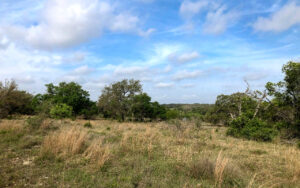
The Scott Shannon Ranch in Blanco County was recently donated to the Hill Country Conservancy. The 367 acres of land lying along U.S. 290 will now be permanently protected under a conservation easement. The ranch contains 1.4 miles of Towhead Creek, which ultimately supplies the city of Austin with a portion of its drinking water.
“In Texas, we owe a lot to private landowners like Scott Shannon, who voluntarily protect their land’s water and wildlife for generations to come,” said Frank Davis, Hill Country Conservancy’s chief conservation officer in a media release. “Thanks to him and the assistance of the Texas Farm and Ranch Lands Conservation Program, these 367 acres will remain a wondrous example of the glory of the Texas Hill Country for many generations to come.”
Matthew McConaughey, Manu Ginóbili lend their voices to Great Springs Project
Article by Mary Claire Patton, Digital Journalist, KSAT

SAN ANTONIO – What might have once been considered a pipe dream is becoming more of a reality as the Great Springs Project continues to work towards protecting and safeguarding four major Texas springs and the lands they flow under.
A nonprofit organization known as the Great Springs Project aims to create 100 miles of hiking trails connecting San Antonio to Austin in an effort to preserve the springs and protect the surrounding land from being developed.
To help demonstrate the importance of the Great Springs Project, the group recently released a short film that shows the beauty and scope of the project while underscoring the urgency of protecting the biodiverse lands of the Texas Hill Country.
It’s Hummingbird Season in Texas. Here’s How to Bring Them to Your Yard
Article By David Hillis for Texas Monthly

Across the Hill Country, feeders filled with sugar water are likely to attract lots of black-chinned and ruby-throated hummingbirds. You may even be lucky enough to spot one of our rarer migrants, such as a rufous or calliope hummingbird. Whichever species of hummer I encounter, it is usually the hum of their rapid flight that first catches my attention. That sound never fails to bring a smile to my face, as I recall the joy I’ve experienced watching and listening to hummers from the shade of our front porch.
Our only regular nesting summer hummer is the black-chinned hummingbird, which is abundant locally. The birds arrive in our area in early to mid-March, and most of the adults have flown south by late summer, although the young often stay until early fall. Ruby-throated hummingbirds are also common here as they migrate through in the spring and fall…
Here’s why you shouldn’t handle or feed young or ‘abandoned’ wildlife
Article by KSAT

SAN ANTONIO – People who see young animals alone in the wild and assume they’re “abandoned” by their mothers should refrain from handling them, according to the Texas Parks and Wildlife Department. TPWD is reminding people to not feed or touch wildlife, especially babies, even if they believe they’re giving a helping hand.
“Texans may start to notice more wildlife in their backyard, neighborhood or surrounding areas. The best thing to do is to leave them alone,” a news release from TPWD states. “Birds, rabbits, deer and snakes become more active this time of year; their young can be mistaken as abandoned.” Handling a young animal may do more harm than good — and it’s actually illegal to possess wildlife in most cases, TPWD says.
Purple Martins Are on the Wing in Texas
Article by Christopher Collins for Texas Monthly

In 1990, wildlife biologist Jim Ray was attending South Dakota State University to complete his master’s degree when he saw the bird that would shape the rest of his life. Ray was visiting a college buddy who had installed a martin house: a birdhouse that’s mounted on a pole and sometimes resembles a gourd or miniaturized apartment building. The backyard structure was inhabited by purple martins, a flashy and personable member of the swallow family known for gathering in large numbers and performing extreme aerial acrobatics. “I couldn’t take my eyes off them,” Ray remembers. “The purple martin feeds high up in the air, way higher than other swallows. Then they will fold their wings, and in one swoop, they drop into their cavity. When I saw that, I was hooked.” Ray isn’t alone in his infatuation with the purple martin, a native bird that makes its entrance into North America each spring from its wintering grounds in South America…
What is it? Wildlife officials stumped as mysterious animal caught on Texas trail camera
Article by Houston Chronicle

Texas park officials have come to the conclusion that the identity of a mysterious animal recently caught on a trail camera at Bentsen-Rio Grande Valley State Park last week is not so mysterious after all. On Saturday, just days after a photo the park posted on Facebook went viral and garnered hundreds of guesses at what the elusive creature pictured hidden among trees at nighttime might be, officials announced that they too agree with most that the animal is most likely an American badger.
They added that the critter is not to be confused with the honey badger that lives in Africa and Asia and “is rumored to not care very much.”
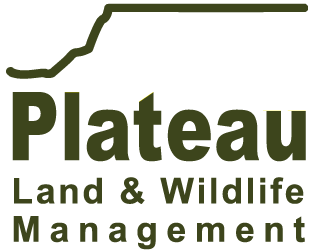




Sorry, the comment form is closed at this time.